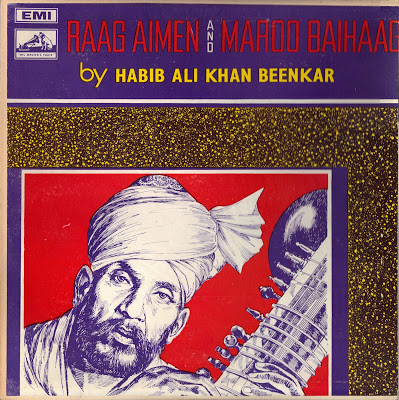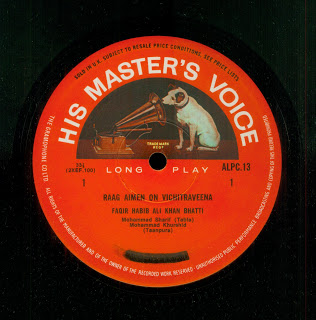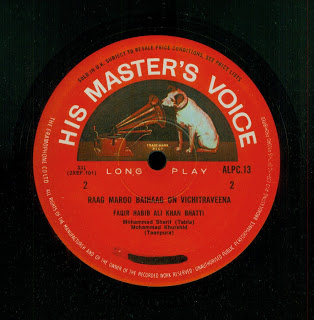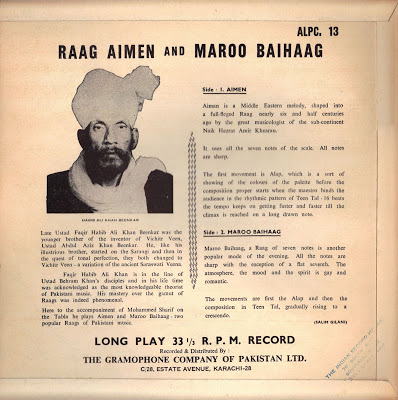Wonderful LP by Ustad Faqir Habib Ali Khan Beenkar, published in Pakistan probably beginning of 1970s.
Side 1:
Raga Aimen (Yaman) (27:15)
Side 2:
Raga Maroo Baihaag (Maru Bihag) ( 27:30)
A fantasic short video of Ustad Habib Ali Khan
and Ustad Ahmedjan Thirakwa 1937:
|
Late Ustad Abdul Aziz Khan Beenkar (Patiala Gharana) (older brother of Habib Ali Khan)
|
The Vichitra Veena emerged towards the beginning of the twentieth century and is descended from the ektantri veena or the ghoshvati veena as it was known, prior to the 6th century. It shared the same sound production techniques as the ektantri. The credit of giving the vichitra veena its present shape and developing its modern style of playing goes to Abdul Aziz Khan, a former sarangi player of Patiala. Today, the vichitra veena remains a rare instrument, with not many artists who play this instrument. In the beginning Abdul Aziz Khan used to play on the tanpura, putting an extra gourd on the upper side and placing the instrument in front of him. Slowly, with the help of many instrument makers, he gave shape to the instrument. In general appearance and structure, the rudra and vichitra veena look similar – the main difference being the production of sound. The rudra veena has frets whereas the vichitra veena is a fretless zither. While playing, the rudra veena is held diagonally across the body of the player in such a manner that the upper gourd rests on the shoulder and the lower one rests on the thigh, whereas the vichitra veena is put in front of the player while playing. To produce notes, a paperweight or a rounded glass piece is held and slid upon the strings using the left hand. Playing fretless instruments, especially with a slide, has to be precise by micrometers in order to get the right note. A minute deviation from the exact place will render it out of tune. Thus, it is rather difficult to play the fast passages on the vichitra veena, but pieces played at a poised and slow pace could be very rich and full of tonal beauty. The vichitra veena is a rare instrument. There are not many artists who play this instrument. Besides, manufacturing the instrument is very laborious and also very expensive. Thus, there are not many instrument makers who can take up this tedious job. Among the students of Abdul Aziz were Ahmed Raza Khan, Mohammad Sharif Khan Poonchwale and his own brother, Habib Ali Khan. In the sixties and seventies, Prof. Lalmani Misra attained fame in vichitra veena playing. Although influenced by Abdul Aziz’ technique, he developed his own style. Some of the other artists who are associated with this rare instrument are Lalmani’s son, Gopal Shankar Misra, Gopal Krishna Sharma, and Ramesh Prem. - Text includes inputs from "Classical Instruments of India" by Dr Suneera Kasliwal |




